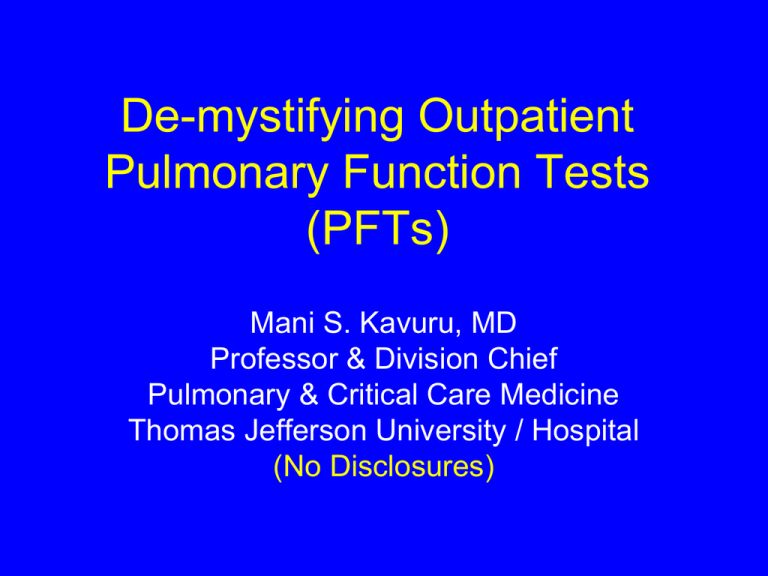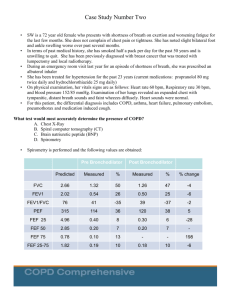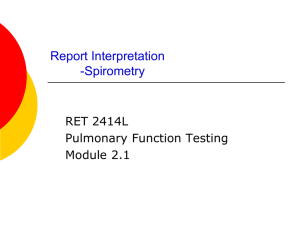Estimating FVC from FEV2 and FEV3
advertisement

De-mystifying Outpatient Pulmonary Function Tests (PFTs) Mani S. Kavuru, MD Professor & Division Chief Pulmonary & Critical Care Medicine Thomas Jefferson University / Hospital (No Disclosures) Key learning Objectives • Consider the concept of spirometry in the primary care setting; • Review the spirometric maneuver, common patterns, concept of normality; • Discuss spirometry in the approach to lung disease; • Briefly review utility of other pulmonary function measures Office Spirometry: Outline • Why do you need it in PCP offices? Utility in screening, smoking cessation • What is spirometry? Basics of technique, interpretation, etc. Office vs. Diagnostic (in labs) • Who could / should perform it? Training, quality control issues • Challenges, controversies? Morbidity and Mortality of COPD • COPD is the 4th leading cause of death • Half the patients die within 10 years of diagnosis • 100,000 deaths/year in the U.S. • $13 billion/year in direct medical costs The Lung Health Study Preliminary Results: • 10 Participating Centers • Patient Demographics – 5,887 current smokers enrolled – Age 35-59 (mean 48.5 ± 6.8 years) – FEV1/FVC 63% ± 5.5 – 63% men, 37% women – 96% white Tashkin DP, et al. Am Rev Respir Dis. 1992; 145 (2 pt) 1):301-10. John Hutchinson (1811 – 1861) References • ATS/ERS position statements; • Books: Miller, Scacci, Gast: Lab Evaluation of Pulmonary Function; Clausen; others • Jefferson interpretation statements; CCF Disease Management document; Pulmonary Function Tests • • • • • Spirogram, +/- BDs Lung volumes Diffusing capacity ABGs, 6 minute walk Bronchoprovocation testing (i.e. mecolyl) • Cardiopulmonary exercise testing HOW: Standardized Testing • Spirometry using ATS & AARC standards – Patient sitting in chair with arms – Use nose-clips! (O2 disconnected) – Reproducible tests, 3 valid efforts min. – No cough in first second – Back extrapolation guidelines (good start) – Good peak flow effort – Exhalation 6 seconds or >1 second plateau Test Reproducibility Non-Reproducible Poor Start of Test Normal Spirometry : Variable Effort Glottic Closure : Cough Mild Obstruction : Severe Obstruction Restriction : Variable Intrathoracic Variable Extrathoracic : Fixed Upper Airway Obstruction Reference Standards Author Year Population Race Spirometer ATS Criteria LLN Hankinson NHANES III 1999 7,249 nonsmokers, U.S. population White, Black, Hispanic Dry rollingseal 1987,1994 Predicted 1.645XS EE Knudson 1983 746 nonsmoking Tucson AZ White Pneumotach 1979 Snowbird 95% CI Crapo 1981 251 nonsmoking 1400m Utah White Water seal metal ball 1979 Snowbird 95% CI Morris 1971 988 no smoking for 6 months, Oregon White Stead wells ACCP Kory 80% Predicte d Spirometric Reference Values From a Sample of the U.S. Population (NHANES III) • Age 8-80 (N=7,429), asympt. nonsmokers, ’88 – ’94 • ATS criteria met (’87, ’94), QA by NIOSH • Caucasians, African-Americans, Mex-Am • Age, standing Ht > weight , BMI • FVC, FEV1, FEV6, PEF, FEF25 – 75 Hankinson. AJRCCM 1999;159:179-187 Spirometry • Two main measurements: – total volume exhaled (FVC) • lung/thorax expansion – HPP, IPF - restrictive lung diseases – volume exhaled in 1st second of exhalation (FEV1) • airway diameter – obstructive lung diseases » asthma, emphysema, chronic bronchitis, etc. Classification of Lung Diseases • Obstructive Disease: asthma; chronic bronchitis; emphysema; CF; • Restriction--Intra-parenchymal disease (lung tissue is abnormal, e.g. HP, pulmonary fibrosis) • Restriction--Extra-parenchymal disease (lung tissue is normal); chest wall deformities, kyphosis, scoliosis, obesity, pleural effusions, ascites – Neuromuscular disorders (“bellows”) Criticism of FEF 25-75% and Other Tests of Small Airway Disease FEF 25-75% • Does not detect small airway disease. • Is volume dependent. • Is affected by elastic recoil, small airways dysfunction and large airways dysfunction. • Is more variable than FEV1, but not as sensitive as FEV1/FVC%. Spirometry Spirometry provides an objective measurement of lung function Measures VOLUME; the amount of air a person can breath in (inhale); and breathe out (exhale) And the SPEED or FLOW RATE that is generated during that maneuver; Into a device called a Spirometer











